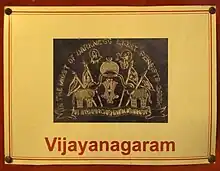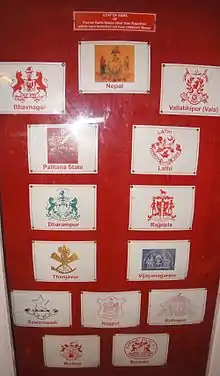Pusapati
Poosapati / Pusapati was the ruling clan of the Northern Andhra region, Vizianagaram.
History


The Pusapati clan claims descent from Madhavavarma, who led a Rajput colony into the Krishna Valley in the late 6th century.[1] The members of the colony subsequently held important positions at the court of Golcanda.[1]
The Pusapati chieftain Sitaram Chandra Raju received the villages of Kumili and Gundredu from Raghunath Krishna Dev of the Jeypore Estate.[2] Viziaram Raju was appointed as an administrative minister of the Jeypore Estate by Ram Chandra Dev I[3] and succeeded his father as the head of the clan in 1710.[1] Viziaram Raju occupied a portion of the coastal territories of the Jeypore Estate under Vishwambhar Dev II[4] and moved the capital of the estate from Potnuru to Vizianagaram in 1712; he named the capital town after himself.[1] Viziaram Raju prompted the neighboring landowners (zamindars) to secede and gain independence from the Jeypore Estate.[3] In 1757, Viziaram Raju formed an alliance with Marquis de Bussy-Castelnau, which allowed him to seize the capital of the rival landowner of Bobbili.[1]
Following Viziaram Raju, the Pusapati clan was led first by Ananda Raju and next by Viziaram Raju II, who was largely controlled by his half-brother Sitarama Raju.[5] In 1761, Sitarama Raju attacked Parlakhemundi defeating its force and their Maratha allies further adding territory to the Vizianagaram Estate.[5] In 1768, Viziaram Raju II claimed the right to hold and cultivate (patta) Kasipuram, Nandapur, Madgol, etc. with the support of and marking the increasing involvement of the British East India Company; this resulted in the dissatisfied landowners rising against Vizianagaram.[6] As Viziaram Raju II was unable to make the requisite revenue collection payments, he was ordered to leave the district.[7] He defied the orders, which resulted in the Battle of Padmanabham against the East India Company Madras Presidency forces led by Colonel Prendergast wherein Viziaram Raju II was defeated and slain.[8]
Following the Battle of Padmanabham, Narayana Babu Raju was unable to quell the increasing revolts from the hill landowners, which ultimately led to further reductions of the Vizianagaram Estate.[8] The successive chieftains Viziaram Gajapati Raju and Ananda Raju proved to be capable leaders and brought in a period of flourishing for the Vizianagaram Estate.[8]
The Pusapatis obtained the title of Gajapati after the battle of Nandapur.[9]
Pusapati rulers


- Sitarama Raju[10]
- Pusapati Amala Gajapati Raju (Founder)
- Pusapati Rachi Gajapati Raju
- Pusapati Tama Gajapati Raju
- Viziaram Raju I (reigned 1710—1757)[1]
- Ananda Raju[5]
- Viziaram Raju II[5]
- Narayana Babu Raju[8]
- Viziaram Raju III (Viziaram Gajapati Raju, reigned 1848—1878)[8][11]
- Ananda Gajapati Raju (reigned 1879—1897)[8][11]
- Raja Pusapati Viziaram Gajapati Raju[8]
- Alak Narayana Gajapati Raju[12]
- Pusapati Vijayarama Gajapati Raju (eldest son of Alak Narayana Gajapati Raju, reigned 1945—1995)[12][13]
- Pusapati Ananda Gajapati Raju (eldest son of Vijayarama Gajapati Raju, reigned 1995—2016)[13][14]
- Pusapati Ashok Gajapati Raju (second son of Vijayarama Gajapati Raju, ascended in 2016)[15][16]
Notable members
- P.S. Kumaraswamy Raja - Former chief minister of Madras State (1949–1952)[17] and governor of Odisha (1954–1956).[18]
- Pusapati Vijaya Ananda Gajapathi Raju (also known as Maharajah of Vizianagram or Vizzy) - Former Indian cricketer,[19] politician,[20] and winner of the Padma Bhushan Award in Sports in 1958.[21]
Notes
- Frowde 1908, p. 339.
- Senapati & Sahu 1966, p. 63.
- Senapati & Sahu 1966, p. 66.
- Senapati & Sahu 1966, p. 67.
- Frowde 1908, p. 340.
- Senapati & Sahu 1966, p. 69.
- Senapati & Sahu 1966, p. 70.
- Frowde 1908, p. 341.
- Satyanarayana 1997, p. 48.
- Richards 1978, p. 55.
- Frenz & Berkemer 2006, p. 1264.
- "A socialist among princes". The Hindu. 5 August 2002. Archived from the original on 25 September 2012. Retrieved 15 July 2023.
- "Ananda Gajapathi Raju passes away". The Hans India. 27 March 2016. Archived from the original on 29 October 2018. Retrieved 15 July 2023.
- "Anand Gajapathi Raju passes away". The Hindu. 26 March 2016. Archived from the original on 29 October 2021. Retrieved 15 July 2023.
- "Ashok Gajapathi Raju". Business Standard. 27 May 2014. Retrieved 15 July 2023.
- "Ashok Gajapathi Raju Pusapati". OneIndia. Retrieved 15 July 2023.
- "List of Chief Ministers of Tamil Nadu". OneIndia. Retrieved 15 July 2023.
- "Odisha Governor List". OneIndia. Retrieved 15 July 2023.
- "Maharajah of Vizianagram Profile - Cricket Player India". ESPN CricInfo. Retrieved 15 July 2023.
- "1962 India General (3rd Lok Sabha) Election Results". Elections.in, 5 Dots Partners. Retrieved 15 July 2023.
- "Padma Bhushan Award Winners". OneIndia. Retrieved 15 July 2023.
References
- Senapati, Sri Nilmani; Sahu, Dr. Nabin Kumar (1966), Orissa District Gazetteers: Koraput, Orissa Government Press Cuttack
- Frowde, Henry (1908), The Imperial Gazetteer of India, Volume XXIV, Travancore to Zira, Oxford at the Clarendon Press
- Richards, J.F. (1978). "Mughal Retreat from Coastal Andhra". The Journal of the Royal Asiatic Society of Great Britain and Ireland. 110 (1): 50–68. doi:10.1017/S0035869X00134227. JSTOR 25210918. S2CID 154680334 – via JSTOR.
- Frenz, Margret; Berkemer, Georg (1 April 2006). "Colleges and Kings: Higher Education under Direct and Indirect Rule" (PDF). Economic and Political Weekly.
- Satyanarayana, Kasimsetty (1997). Gurazada: A Biographical Study (PhD thesis). University of North Bengal.